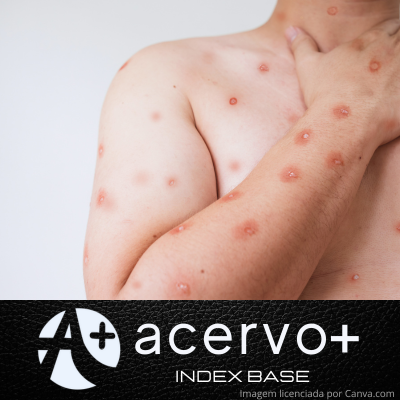Monkeypox: uma abordagem dermatológica
##plugins.themes.bootstrap3.article.main##
Resumo
Objetivo: Elucidar o processo clínico-patológico da Monkeypox para melhor compreensão dessa afecção no âmbito dermatológico. Revisão bibliográfica: A Monkeypox é uma zoonose causada pelo vírus monkeypox (MPXV), transmitida por contato com lesões cutâneas, fluidos corporais ou fômites. O vírus penetra nas células hospedeiras, replicando-se localmente e disseminando-se para linfonodos e outros órgãos. Os sintomas prodrômicos, como febre, linfadenopatia e mal-estar, são seguidos por erupções cutâneas características que variam de máculas a pústulas. O diagnóstico é confirmado por PCR em amostras de lesões cutâneas. A vacinação contra varíola apresenta cerca de 85% de eficácia contra o MPXV, e tratamentos antivirais como Tecovirimat têm mostrado potencial na redução da gravidade da doença. A revisão aborda as complicações, incluindo infecções secundárias e envolvimento de órgãos internos, especialmente em pacientes imunocomprometidos. O aumento recente de casos fora da África enfatiza a necessidade de estratégias diagnósticas e terapêuticas eficazes. Considerações finais: A identificação precoce e intervenções terapêuticas apropriadas são cruciais para minimizar riscos e prevenir complicações. Implementar medidas preventivas eficazes e assegurar o manejo adequado da doença são essenciais para proteger os grupos de maior risco.
##plugins.themes.bootstrap3.article.details##
Copyright © | Todos os direitos reservados.
A revista detém os direitos autorais exclusivos de publicação deste artigo nos termos da lei 9610/98.
Reprodução parcial
É livre o uso de partes do texto, figuras e questionário do artigo, sendo obrigatória a citação dos autores e revista.
Reprodução total
É expressamente proibida, devendo ser autorizada pela revista.
Referências
2. ALAKUNLE E, et al. Monkeypox virus in Nigeria: infection biology, epidemiology, and evolution. Viruses, 2020; 12(11): 1257.
3. ALJABALI AA, et al. Recent advances in understanding monkeypox: epidemiology and interventions. Microbial Pathogenesis, 2023; 170: 105748.
4. ALLAN-BLITZ LT, et al. Epidemiology and clinical characteristics of recent monkeypox cases in the USA. Journal of Infection, 2022; 85(5): 562-569.
5. ALORFI NM e ALSHEHRI FS,et al. Characterization of interventional clinical trials for monkeypox; systematic review of ClinicalTrials.gov database. Frontiers in Public Health, 2023; 11: 1144325.
6. ALTINDIS M e PUCA E, et al. Diagnosis of monkeypox virus – An overview. Travel Medicine and Infectious Disease, 2022; 50: 102459.
7. ASAAD S, et al. Cutaneous eruptions associated with monkeypox virus infection: A systematic review. JAAD International, 2023; 12: 179-181.
8. BADGE H, et al. Neurological complications of monkeypox: a systematic review and synthesis of case reports. Journal of Clinical Virology, 2023; 161: 105426.
9. BARBOZA JJ, et al. Virus identification for monkeypox in human seminal fluid samples: a systematic review. Tropical Medicine and Infectious Disease, 2023; 8: 173.
10. BEER E, et al. Rapid risk assessment: monkeypox multi-country outbreak. European Centre for Disease Prevention and Control, 2022; 2: 1-13.
11. BENITES-ZAPATA VA, et al. Incidence of monkeypox and risk factors for mortality among children and adolescents: a systematic review and meta-analysis. Travel Medicine and Infectious Disease, 2023; 51: 102473.
12. BUNGE EM, et al. The changing epidemiology of human monkeypox: a systematic review. PLoS Neglected Tropical Diseases, 2022; 16(2): 10141.
13. CHEEMA AY, et al. Monkeypox: A review of clinical features, diagnosis, and treatment. Cureus, 2022; 14(7): 26756.
14. D’ANTONIO F, et al. Monkeypox infection in pregnancy: a systematic review and metaanalysis. American Journal of Obstetrics & Gynecology MFM, 2023; 5: 100747.
15. GANDHI AP, et al. Emerging role of tecovirimat in the treatment of monkeypox: a review. Journal of Clinical Virology, 2023; 161: 105428.
16. HASAN MM, et al. Monkeypox in 2022: Clinical features, epidemiology, and combating strategies. New Microbes and New Infections, 2022; 47: 100975.
17. HUANG C, et al. Clinical features and management of monkeypox: a rapid review. New Microbes and New Infections, 2022; 46: 100905.
18. KUMAR D, et al. An overview on monkeypox virus: Emerging trends and future prospects. Journal of Clinical Virology, 2022; 148: 105081.
19. LÉON-FIGUEROA DA, et al. Detection of monkeypox virus according to the collection site of samples from confirmed cases: A systematic review. Tropical Medicine and Infectious Disease, 2023; 8: 4.
20. LI P, et al. Epidemiological and genetic characteristics of the monkeypox outbreak in non-endemic regions. BMC Infectious Diseases, 2022; 22: 965.
21. MAULDIN MR, et al. Human monkeypox - U.S. case of symptomatic relapse and review of the literature. Emerging Infectious Diseases, 2022; 28(12): 2255-2263.
22. PETERSEN E, et al. Human monkeypox: epidemiologic and clinical characteristics, diagnosis, and prevention. Infectious Disease Clinics of North America, 2019; 33(4): 1027-1043.
23. RANI I, et al. Recent developments and therapeutic approaches for monkeypox virus. Journal of Infection and Public Health, 2023; 16(4): 560-569.
24. SATAPATHY P, et al. Potentially asymptomatic infection of monkeypox virus: A systematic review and meta-analysis. Vaccines, 2022; 10(12): 2083.
25. SHAMIM MA, et al. Dermatological aspects of monkeypox: current knowledge and perspectives. Clinical Dermatology, 2022; 40(5): 725-732.
26. SHARMA A, et al. Therapeutic options for monkeypox: insights into the current and future perspectives. Journal of Clinical Medicine, 2023; 12(4): 1267.
27. SUDARMAJI N, et al. Genomic and proteomic analysis of monkeypox virus isolates from the current outbreaks. Viruses, 2022; 14(10): 2257.
28. VIDELEFSKY D, et al. Herpes and chest pain: two atypical monkeypox cases. Cureus, 2023; 15(1): 33705.

